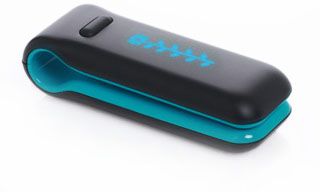
After waiting six months on a pre-order waiting list, I finally got my Fitbit two months ago. I was really looking forward to it — as a big fan of the Nike+ running tracking system, I was excited about Fitbit’s promise to not only track my running and walking, but to track my sleep patterns as well. And the design was extremely seductive — small in size, elegantly combining form and function (it doesn’t have a clip, it is a clip), and with a magical blue led screen that is invisible when the device is off. How could I resist?
And I was right: I love the Fitbit!
But I don’t want to use it any more. How is that possible?
First, though, you may be asking “What is Fitbit?” Fitbit is a personal health tracking system consisting of a small electronic device that you clip to your body to track your movements and a web site that uses the data from those movements to give you detailed reports and analysis of your fitness and health. The Fitbit device contains an accelerometer to detect anything from a single running stride to tossing and turning in your sleep, and it wirelessly syncs to your computer via a small radio transmitter. The Fitbit has a small digital display indicating the number of steps you’ve taken, how far you’ve walked or run, and how many calories you’ve burned.
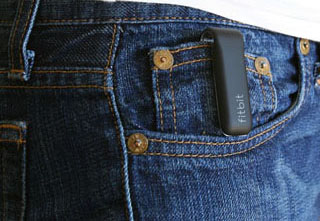
Basically, you clip the Fitbit on your waist all day long, and to a wristband at night, to collect 24/7 data about your body’s movements. The Fitbit web site then slices and dices that data to present some pretty fascinating insights into your personal health.
Sounds simple? It’s supposed to. There is an emerging trend in personal electronics and software to stop bothering users with long explanations of “how it works”, and to instead keep the interactions simple and just make sure the damn things work. Fitbit is right on that wave. The documentation doesn’t say much about how it works, the web site doesn’t have a big “how it works” page. You’re just supposed to start using it.
So Fitbit cuts to the chase in most of their user experience designs. In fact, I can’t find anything on the Fitbit home page that says “Fitbit is …”. Fitbit is what it does, which is count your movements and interpret that information.
I think that’s part of Fitbit’s strategy: to experiment with giving users a minimal level of explanation to get people focused on changing their behavior and thus their health, and not on requiring users to constantly be manipulating the technology.
Getting Fitbit
Let’s first discuss the centerpiece of the Fitbit system, the Fitbit device itself. It’s about the size of a money clip or a small pack of gum, clips easily to clothing and fits easily in a pocket. Some users complain that it is easy to lose, and while I managed to hold on to it for two months, I can only attribute that to luck. I am really impressed by the “clip” form factor (versus a wristband, a strap, a card, a keyfob). Given the required size, it’s a clever solution.
The digital display is incredibly nice to look at. When it’s off, it’s just a detail-less smooth black surface. When you press the Fitbit’s single button, however, the display shines through the now-translucent plastic like shining a flashlight through your fingertip.
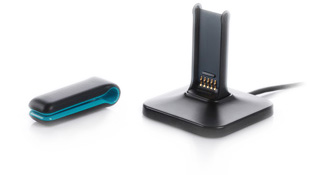
When you bring the device near the charging/base station, it automatically uploads the latest data from the device. The base station is clever, but I think it over-fetishizes the Fitbit itself by literally placing it on a pedestal, as many upright docking stations do for the iPhone. And its 18″ cord is overkill. While it is quite clever to allow the device to sync automatically, you still have to turn your computer on in the first place, and if you’ve got a laptop you have to plug in the base station anyway. So syncing isn’t invisible for most people, I suspect, but is rather a conscientious and deliberate daily act.
A syncing solution like the original iPod Shuffle’s, where the device itself had a USB plug built-in, would permit charging and syncing without an additional base station device and, as I contend, without adding an additional sync action for most users. A Bluetooth version to sync with high-end laptops without charging would be even better.
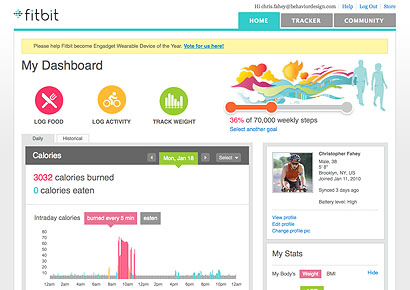
The web site is fantastic. The data displays are lovely, and it’s easy to get around and play with your data. I do have problems with many of the specific information design and charting decisions, but I am not going to complain because the Fitbit folks are constantly evolving and improving the site, tweaking features, responding to user feedback, adding new stuff.
Interestingly, you can use the Fitbit web dashboard without owning a Fitbit. First of all, the site lets you manually enter your food consumption information in order to establish your caloric intake each day. Also, it lets you manually enter your exercise activities as well.
I actually suspect the designers must have conscientiously kept the site device-agnostic, to support future Fitbit devices and to invite non-Fitbit users to join the web community.
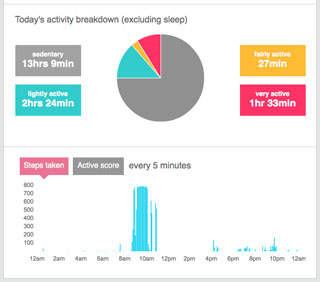
Using the device as a pedometer, which is by far Fitbit’s core function, is simple. I can see the distance I’ve walked at any time during the day, and when I get home I can see a day-by-day report on the web of how far I’ve walked, and how far I walk each day on average. The device’s step-counting accuracy is astonishingly accurate: I did a test, walking and counting up to 1000 steps in my head, then checked the Fitbit and saw it counted 1004. That’s plenty accurate for me.
For running, Fitbit detects the nuances of difference between a running and walking motion, and then recalculates your distance traveled (based on longer stride length) and calories burned accordingly. There is simply need to tell Fitbit that you’re running and not walking. It’s smart enough to tell, based only on the nature of the data it’s collecting. As for running accuracy, I wasn’t able to do a counting test, but the distances Fitbit reported on several over-5-mile runs were 10-20% different from the distances reported in Google Maps. Far from ideal, but on par with the similar inaccuracy of Nike+.
Where Fitbit gets really clever, however, is with sleeping. Obviously a motion sensor isn’t able to tell if you are sleeping or just lying on your ass watching TV. Fitbit requires you to press and hold the devices’s single button for a few seconds, putting the device into a kind of “special activity” mode. Fitbit comes with a surprisingly non-obtrusive wristband that holds the Fitbit device while you sleep. As you sleep, the Fitbit detects your body’s movements and uses these cues to determine how long it took you to actually fall asleep, how many times, and precisely when, you moved around in the middle of the night, and when you woke up. In the morning, you press and hold the button again to indicate that you’re awake and walking around again.
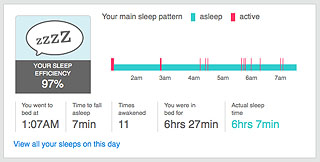
The sleep data collected is fascinating, and this alone is worth the price of admission. You probably have no idea about how long it takes you to fall asleep, or how often you toss and turn. I certainly didn’t, and was delighted to see the results. I found it incredibly interesting to see the day-by-day durations of my sleeps for an entire month (little more 2 hours more than a few times, around 6 hours most of the time, and 12 hours on one blessed Friday night).
For other activities, such as cycling or weightlifting, Fitbit isn’t so smart. For such things, Fitbit literally requires you to manually manipulate the data. Again, for people in highly-structured weight loss programs where counting calories in and out is important, Fitbit’s web dashboard offers the ability to manually enter your non-walking or running activities to make sure your overall caloric burn rate is kept accurate.
An amusingly large number of people in the forums ask about the fitbit’s ability to measure calories burnt during sex, some with a measure of sexual bravado (“wear on my hip?”), others innocently but rather seriously dedicated to counting every calorie burned. While I admire the free spirited nature of these inquirers, I cannot offer any additional insight into this matter as I, perhaps overly romantically, still beleive that some things remain well beyond quantification.
The Fitbit Ecosystem
The Fitbit web site is constantly changing, and they keep adding features to the site, extending the functionality of the fixed hardware system. This is part of the clever concept that the features entirely lie in the interpretation of data. It’s a radical simplification of what software is all about: Fitbit’s one motion sensor and one binary button (ternary if you count the long 2-second press, and potentially more if you add longer presses, or even double and triple presses as on the iPhone earbud controller) have the potential to enable a lot more interaction and communication than one might think at first blush.
In a way, they are squeezing as much functionality out of the tech as possible. Fitbit is a small embodyment of Don Norman’s recent claim that technology leads and design follows. For Fitbit, it’s an inspired design response to the question “how many things can we do with just this one bit of technology”?
To contrast this with Nike+ for a moment, Fitbit feels far more like a living thing, run by engaged people dedicated to incremental changes in response to the actual usage by their community and feedback in their incredibly active and helpful forums. It’s a Web 2.0 product. Nike+, however, is a more traditional product, with huge and infrequent X.0 product launches. Nike+ stagnated with the same beautiful and innovative — but buggy and slow — web site for years, only to upgrade this year to a new, buggier, and unfortunately even more awkward user interface. Nike+ still never remembers users passwords, for example. I wish Nike+ would follow Flitbit’s lead when it comes to incremental, simple improvements. Focus on a UI that can scale and evolve, and not on one that is sexy and “bold”.
Product Conclusions
There are probably two kinds of Fitbit customers. First, casual users: people who want to know more about what they do with their bodies, people who are curious about their health and the potential to use technology to keep closer tabs on how well they’re doing. This describes my interest in Fitbit.
The second group is serious users: people who are actively trying to change their personal health behaviors and want a way to measure those changes. If you’re trying to change an overly-sedentary lifestyle, to lose weight through careful monitoring of calories burned versus consumed, Fitbit might be a huge help. For people involved in a structured weight loss program, a device that adds to that regime is perfectly normal. But I walk plenty each day (4-5 miles every day). I am an athlete and run often, but I don’t count calories. I’m not trying to lose weight. I use Nike+ to measure my special activities (running), but I don’t want a new device attached to me all the time just to give me data about my normal activities, just to satisfy my curiosity.
So while I found Fitbit useful and delightful, it was only temporarily. But that’s okay. It’s a fantastic tool for self-analysis, to get to know your sleep patterns, your typical daily walking distance. Great information. But once you have that information, if you’re not engaged in a program to change those things, you’re done with Fitbit. I know everything Fitbit can tell me. Maybe I’ll try it again in six months or a year, to see if I’ve changed. I’m a casual user.
The Fitbit is not what I and other casual users might have hoped it would be. It’s not going to be a permanent part of your life, a constant and consistent way to monitor your health. The biggest obstacle to this, I think, is unfortunately still technological. It’s just too big to carry with you in every possible context, so you end up taking it on and off over and over again all day. When you change clothes, you have to move it from one garment to another. At night, you have to strap on a wristband and clip it to that. You have to take it off in the shower.
Inevitably, I ended up forgetting to bring it to work occasionally. Or I’d have it unclipped for part of a day. Which is far worse than it sounds: If you miss a day of walking in a week, it completely ruins the accuracy of your weekly average. Miss a few days in a month, and your monthly average is shot to hell. Fitbit lets you manually enter your information, but I’ll be damned if I’m going to do Fitbit’s job for it! You’ve got have your Fitbit on your person almost 90% of the time for it to produce accurate trends and summary results, the kind of results that justify integrating it into your life in such a serious and committed way.
If the Fitbit was the size of a fingernail, attached with waterproof glue or embedded under my skin, well, then we’re talking. But because of its size, it becomes one more thing to inhabit my intimate attention space, something I have to remember to never leave home without, like my phone, my wallet, and my pants. It’s like having a little adopted pet you have to take care of all day.
In short, you just can’t lead a normal life with Fitbit. If there’s one thing I’ve learned from the Fitbit experience, a lesson about the future of personal informatics, it’s that we simply won’t have accurate and reliable personal systems until the devices themselves are immune to these everyday emergencies and accidents and inconveniences. Until they’re virtually invisible and forgettable, probably embedded under the skin, we will be forced to consider personal informatic hardware as intrusive medical devices rather than as the ethereal, ambient data sources I think many people envision.
If you want an informatically-based weight loss program, with increased walking as a core element, and if you want to count calories in and out, Fitbit is for you and might help you with your program over the months and years.
If you are interested in just finding out about your body and how you use it, it’s great for that, too. Give it a spin, then hand it off to another person. Want mine?